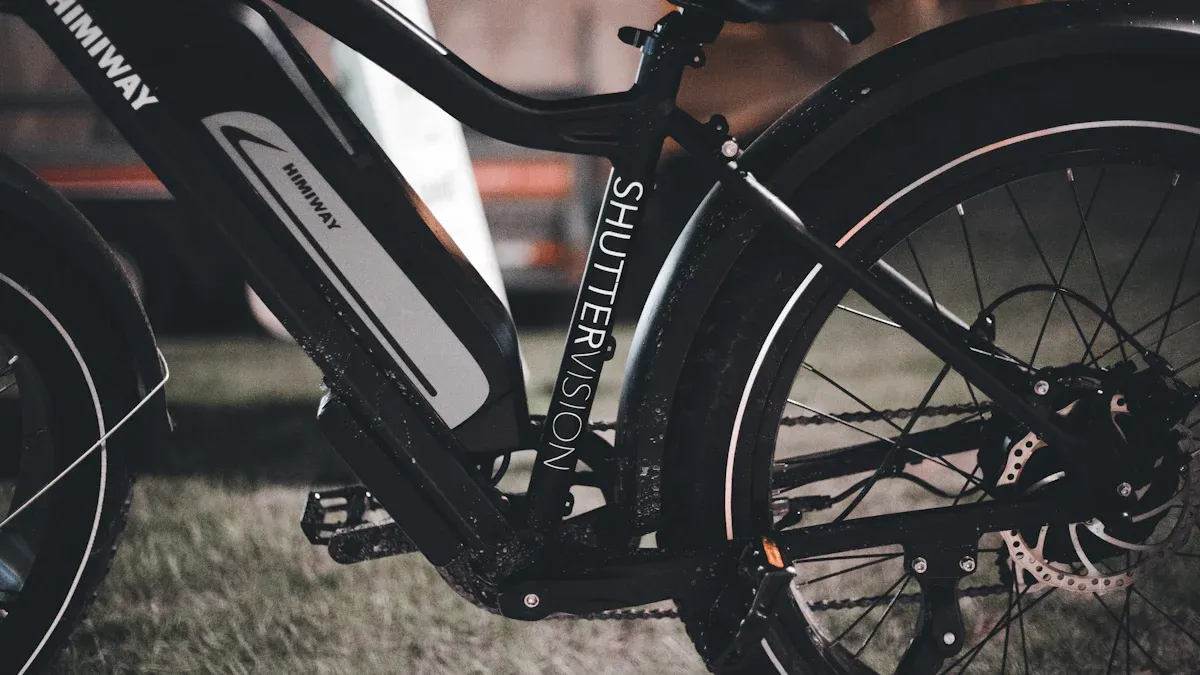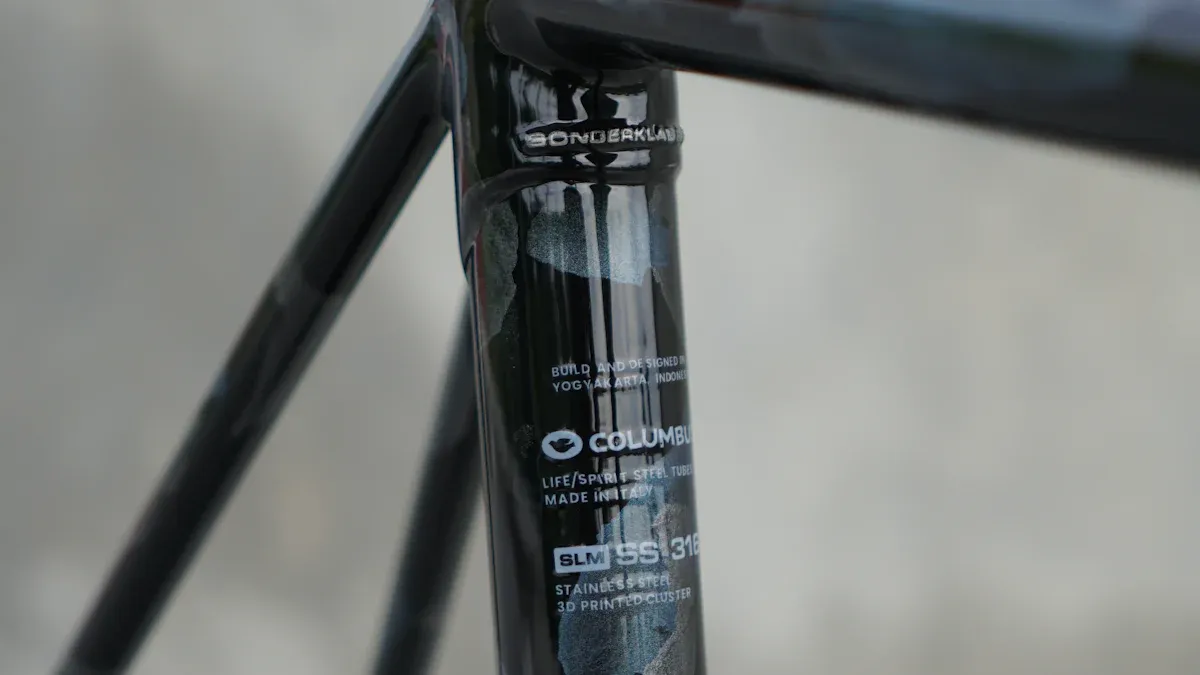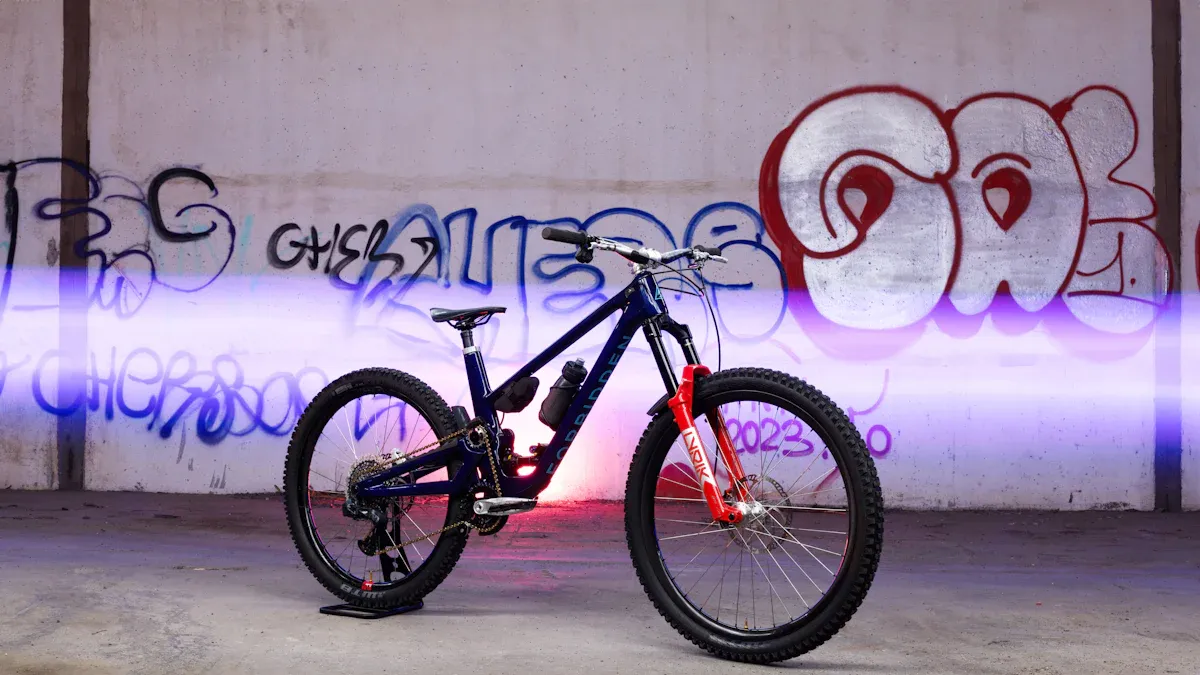
You will see four main electric bike frame materials today. These are aluminum, carbon fiber, steel, and titanium. Each material has its own special strengths for bike frames. Aluminum is known for being stiff but light and not too expensive. Carbon fiber is great for top performance and has a stiff and fast shape. Steel is strong and gives a smooth and comfy ride. Titanium is fancy and mixes strength, lightness, and lasts a long time. The table below shows the good things about each frame material. This can help you pick the best one for your electric bike’s comfort and performance.
Material | Commonly Cited Advantages |
|---|---|
Aluminum | Very stiff but light; not costly; tough; better ride feel |
Carbon Fiber | Very stiff and light; fast shape; high performance; costs more |
Steel | Tough; comfy; easy to fix; classic look; lasts long |
Titanium | Fancy; strong and light; does not rust; smooth ride; lasts a long time |
Key Takeaways
Aluminum frames are strong and do not rust. They cost less and work well for city rides. They are good for daily use.
Carbon fiber frames are the lightest frames. They give a smooth and fast ride. But they cost more and are harder to fix.
Steel frames are very tough and last a long time. They make rides more comfortable by soaking up bumps. They are good for long trips and heavy things.
Titanium frames are light, strong, and comfy. They do not rust for a long time. But they cost the most money.
Pick your frame by how you ride and your budget. Think about weight, comfort, or how long it lasts. This helps you get the best electric bike.
Aluminum Electric Bike Frames
Properties of Aluminum
Aluminum is a very common material for electric bike frames. It gives a good mix of light weight, strength, and price. Most companies use 6061 alloy because it is strong and lasts a long time. When 6061-T6 aluminum is heat treated, it gets even tougher. This helps your bike handle bumpy roads and heavy things. Aluminum frames are heavier than carbon fiber but lighter than steel. This makes them a good choice for many people. The table below shows how aluminum stacks up against other frame materials:
Material | Weight | Strength & Stiffness | Cost | Typical Use Cases |
|---|---|---|---|---|
Aluminum Frame | Moderate weight | Good stiffness, moderate vibration damping | Affordable | Urban commuting, entry-level eBikes |
Carbon Frame | Lightweight | Superior strength-to-weight ratio, excellent shock absorption | Premium | Performance road and mountain bikes |
Steel Frame | Heavier | Exceptional toughness, good shock absorption | Economical to mid-range | Utility bikes, long-distance touring |
Titanium Frame | Lightweight | Excellent durability and corrosion resistance | High-end | High-performance, custom builds |
Pros of Aluminum Frames
Aluminum frames have many good points. They are light and give you a fast ride for a fair price. Aluminum does not rust, so you do not have to worry about that. The frame is stiff, so when you pedal, the power goes right to the wheels. This helps you speed up and steer better. Aluminum frames are strong and can last over 10 years if you take care of them. Many people pick aluminum because it is reliable and a good deal. Here are some pros of aluminum:
Strong enough for daily rides and rough roads
Costs less than titanium or carbon fiber
Does not rust, so it lasts longer
Works well for city rides and adventures
Easier to replace than carbon if it breaks
Tip: Clean your aluminum frame and store it well to make it last longer.
Cons of Aluminum Frames
Aluminum frames also have some downsides. You might feel more bumps because aluminum sends vibrations to your hands and body. This can make long rides less comfy. Aluminum is heavier than carbon, so you need more effort to go fast. Over time, aluminum can get dents or wear out, making it feel softer. You should check your frame after any crash or hard hit. Here are some cons of aluminum:
Does not absorb shocks as well as steel or carbon fiber
Weighs 2-3 pounds more than carbon frames
Can get dents and wear out after many years
Not as easy to shape, so it is less aerodynamic
Think about these pros and cons before picking aluminum for your electric bike frame. Aluminum is strong, lasts long, and is not too expensive, so it is a smart pick for lots of riders.
Carbon Fiber Electric Bike Frame Materials

Carbon Fiber Properties
Carbon fiber is a top material for electric bike frames. It is made from thin carbon strands woven together in resin. Carbon fiber is very strong for its weight. The fibers can handle a tensile strength of about 2,500 MPa. This means they are strong but not heavy. The stiffness depends on how the fibers are placed. Usually, it is stiff along the fiber direction. Bike makers use this to make frames that are stiff for pedaling. These frames also absorb bumps well. Carbon fiber frames are about 20-30% lighter than aluminum frames. They often weigh 2-3 pounds less. This makes bikes easier to handle and helps you ride better.
Material | Relative Weight | Notes on Weight Comparison |
|---|---|---|
Carbon Fiber Frame | Very light | Typically 20-30% lighter than aluminum; about 2-3 pounds lighter |
Aluminum Frame | Moderate | Heavier than carbon fiber; baseline for comparison |
Steel Frame | Heavy | Heavier than both carbon fiber and aluminum |
Titanium Frame | Lightweight | Nearly as light as carbon fiber but more expensive |
Pros of Carbon Fiber Frames
There are many good things about carbon fiber frames. They are light and help you ride faster. You use less battery power with a lighter frame. Carbon fiber absorbs vibrations, so your ride feels smoother. This is great for rough roads or long trips. Carbon fiber lets makers create cool frame shapes. These shapes help the bike move through air better. Many riders say carbon fiber frames feel smooth and help them get less tired.
Pros of carbon fiber frames include:
Very light, so bikes are easy to lift and move
High performance because of stiffness and strength
Great at soaking up bumps for more comfort
Modern look with shapes that cut through air
Note: Carbon fiber frames cost more than aluminum or steel frames. You pay more for better performance and comfort.
Cons of Carbon Fiber Frames
There are also some downsides to carbon fiber. Carbon fiber frames cost more than most other frames. They are usually premium products. If your frame gets damaged, repairs can be expensive. Fixing them can cost between $400 and $700. Carbon fiber can break suddenly if hit hard. Sometimes you cannot see the damage from the outside. Problems like delamination or fiber breakage need an expert to check. Parts near the motor or battery can get damaged more easily. Carbon fiber does not bend like metal. It can crack or splinter if stressed.
Common cons of carbon fiber frames:
Higher price than aluminum and steel
Repairs are expensive and not simple
Can break suddenly after a hard hit
Hard to see inside damage without special tools
Material | Vibration Damping | Rider Comfort Impact |
|---|---|---|
Carbon Fiber | Results in a smoother ride, especially over long distances and rough terrain, reducing rider fatigue | |
Aluminum Alloy | More rigid, transfers vibrations | Leads to a rougher ride, especially on uneven surfaces, increasing rider fatigue |
When you look at the pros and cons, carbon fiber is great for performance and comfort. If you want a light and high performance electric bike, carbon fiber is a top pick.
Steel Ebike Frame Durability
Steel Frame Properties
Steel is a classic choice for electric bike frames. It is very strong and does not break easily. Steel can carry heavy things and handle bumpy roads. It bends a little, so it soaks up shocks and bumps. This makes your ride feel smoother. Bike makers use chrome molybdenum or high carbon steels. These steels get welded and heated to make them even stronger. Steel frames keep their shape for many years. If a steel frame gets damaged, it is easy to fix. This helps the frame last longer.
Steel frames can last more than 10 years if you take care of them. They often last longer than the battery or motor on your electric bike.
Pros of Steel Frames
Steel frames have many good points. They are tough and last a long time. Steel soaks up road bumps, so you feel less shaking. This is good for long rides or rough paths. Steel frames do not break all at once because they are strong and bendy. If your frame gets a dent or scratch, you can fix it by welding. Fixing steel is not hard and helps your bike last longer. Many people like how steel looks and trust it to work well.
Here are some main pros:
Very tough for daily rides and hard roads
Strong enough for heavy loads and bumps
Smooth ride because it soaks up vibrations
Easy and cheap to fix if it breaks
Lasts a long time, often over 10 years
Aspect | Details |
|---|---|
Steel bends a bit and soaks up bumps, so your ride is smoother. | |
Durability | Steel frames are strong and do not break suddenly. |
Repairability | You can fix steel frames easily, often by welding. |
Cons of Steel Frames
Steel frames also have some downsides. Steel is heavier than aluminum or carbon fiber. This makes your bike feel heavier and harder to speed up. The extra weight can use more battery power. Steel can rust, especially if it gets wet or sweaty. Rust shows up as spots, sometimes under the paint. You can stop rust by cleaning your frame and using sprays. Painting or powder coating helps stop more rust. All steel can rust, but cleaning it often keeps it strong for years.
Steel frames often get surface rust, mostly on the top tube.
Rust can show up under paint if the frame was not cleaned well first.
Most rust is just on the surface and can be cleaned off.
If you take care of your steel frame, it will last a long time with little rust.
Tip: Clean your steel frame often and keep your bike dry to help it last longer.
Titanium Electric Bike Frames
Titanium Properties
Titanium is a top choice for electric bike frames. It is light and very strong. Titanium feels light because it has low density. The Ti-6Al-4V alloy is the most common type. This alloy is strong and lasts a long time. It can handle lots of stress without breaking. The table below shows how titanium compares to other materials:
Property | Grade 2 (Pure) | Grade 5 (Ti-6Al-4V) | Notes |
|---|---|---|---|
Tensile Strength | Over 1400 MPa | Grade 5 is used for most bike frames | |
Yield Strength | ~275 MPa | ~880 MPa | High yield strength for demanding rides |
Fatigue Resistance | N/A | Up to 5x aluminum/steel | Excellent for long-term use |
Density | ~4.5 g/cm³ | ~4.5 g/cm³ | Low density for a light frame |
Titanium frames do not rust or corrode. You do not need to worry about rain or wet roads. Titanium keeps its shape and strength for many years. It works well even if you use your bike a lot.
Pros of Titanium Frames
Titanium gives you a smooth and comfy ride. It bends a little, so it absorbs bumps and shakes. This helps you feel less tired on long rides. Many people say titanium frames feel lively and springy. The frame is tough but also gentle on rough roads.
Titanium frames absorb bumps for a smoother ride.
The frame’s flex helps you feel less tired.
You can ride on gravel, pavement, or trails with comfort.
Titanium does not rust, so your frame stays strong and looks good.
Titanium is very strong, so your frame lasts for years.
Tip: Titanium is great for long rides or mixed paths. It gives you comfort and good performance.
Cons of Titanium Frames
Titanium frames cost more than most other frames. The price is high because titanium is expensive. Making and fixing titanium frames needs special skills. Not every shop can repair titanium frames. Repairs may take longer and cost more.
Titanium frames are some of the most expensive.
Building and fixing titanium needs special tools and skills.
Repairs are harder to find and cost more than other frames.
Titanium frames are strong and work well. But you should think about the high price and repair needs before you choose titanium.
Electric Bike Frame Comparison

Frame Materials Table
You might want to know how the main frame materials are different. The table below shows how they compare in weight, strength, comfort, and price. This can help you pick the best one for your needs.
Frame Material | Weight | Durability | Comfort | Cost |
|---|---|---|---|---|
Carbon Fiber | Lightest; best for weight savings | Less durable against impact; can be fragile | Best comfort and responsiveness due to tunable stiffness and compliance | Most expensive |
Aluminum | Good weight; lighter than steel but heavier than carbon | Durable but prone to fatigue over time | Less comfortable than carbon fiber | More affordable |
Steel | Heaviest among the four | Most durable; highly resistant to fatigue; easily repaired | Most comfortable due to elastic properties | Moderate cost |
Titanium | Lighter than steel but heavier than carbon and aluminum | Durable with corrosion resistance | Comfortable, combining steel’s comfort with lighter weight | Most expensive; premium option |
Tip: Decide what matters most—weight, strength, comfort, or price—when you look at this table.
Choosing the Right Frame
The best frame material depends on how you will use your electric bike. If you want a light and cheap bike for city rides, aluminum is a good pick. It does not rust and saves you money. If you want the smoothest and fastest ride, carbon fiber is the best. It is light and comfy, but it costs more and needs careful use.
Steel frames are the strongest and give a soft ride. If you want to carry heavy things or ride far, steel is a smart choice. You can fix it if it breaks. Titanium is strong, comfy, and light. It does not rust and lasts a long time, but it is the most expensive.
Here are some quick tips for picking your frame:
For city rides: Pick aluminum for a light, rust-free, and cheap bike.
For mountain biking: Choose steel or titanium for strength and shock absorption.
For long trips: Go with steel or titanium for comfort and strength.
For speed: Pick carbon fiber for the lightest and fastest ride.
Every rider wants something different. Think about how you ride, your budget, and what you want most. This will help you choose the best frame for your next ride.
Picking an electric bike frame is about what matters to you. Look at the table below to see your choices:
Frame Material | Durability | Comfort | Cost | Best For |
|---|---|---|---|---|
Steel | High | High | Low-Moderate | Riders who want strong frames and comfort |
Aluminum | Moderate | Low-Moderate | Low | People who want light bikes and low prices |
Carbon Fiber | High (but fragile) | Moderate-High | High | Riders who want speed and top performance |
Titanium | Very High | High | Very High | Riders who want the best durability and comfort |
Think about how you ride and how much you want to spend. Steel and titanium are good if you want a tough and comfy bike. Aluminum is good if you want a bike that is light and does not cost much.
FAQ
What is the lightest material for electric bike frames?
Carbon fiber is the lightest material you can choose. You get a bike that is easy to lift and move. This helps you ride faster and use less battery power.
Can aluminum frames rust over time?
Aluminum frames do not rust. You can ride in wet weather without worrying about rust. You only need to clean your frame to keep it looking good.
Are steel frames good for long-distance rides?
Steel frames work well for long trips. You get a smooth ride because steel absorbs bumps. Many riders choose steel for comfort and durability on long journeys.
Why do titanium frames cost more than other materials?
Titanium is rare and hard to work with. You pay more because it lasts a long time and does not rust. Titanium frames give you a smooth ride and high strength.
See Also
Exploring The Science Powering Carbon Fiber Bicycle Frames
How Carbon Fiber Enhances Smoothness And Lightness In Riding
The Importance Of Selecting Proper Bike Frame Geometry
Factors That Determine The Perfect Bike Frame Fit
Understanding Geometry To Choose Your Best Mountain Bike Size
